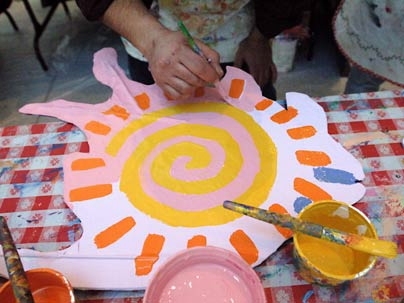Something fishy has been happening at the Stata Center.
Look up from the Student Street, and you'll see brightly colored mobiles of fish, birds and turtles spinning in the air currents, each mobile carrying a message about water as a globally threatened resource.
Created by members of the MIT community and others, under the direction of artist-in-residence Cindy Snodgrass, this temporary installation, "S.O.S.-Fish," is designed to embody a simple message: "Water unites us. We are the quality of our water," Snodgrass said.
Some of the messages on the fish include, "Around the world, women and children spend hours each day transporting water from its sources to their homes"; "Air is water with holes in it"; and "The largest monster in the world's water closet is Abrupt Climate Change."
Snodgrass, who said she thinks art can be an "engine of community, of discourse and of action," said she hopes the take-home message from the exhibit will be to "research for yourself about water. What comes out of your faucet is not all you need to be looking at."
"S.O.S-Fish" debuted at MIT during the Alumni Association's family weekend in October, and the community and passers-by have expanded the exhibit throughout its time at Stata. There have been a number of informal drop-in painting events in Stata's Taiwan Semiconductor Manufacturing Company Lobby, and a lobby table is set up to invite passers-by to contribute facts and opinions about water for the mobile's informational "bubbles."
An Independent Activities Period course, "Assist the Fish -- Environmental Art Installation/Mentoring," was also held in the lobby. Undergraduates in that class mentored children's groups contributing to the exhibit.
"S.O.S.-Fish" will remain on display until the first week in March.
"The fish make me smile every time I go by them," said Associate Professor Daniela Rus, who works in Stata. "My little girls, 4 and 6, were really excited to have a chance to paint a fish and they brought the safe water message to their respective schools."
Debra Kedian, who manages the Stata Center space through the Campus Activities Complex, said she has received consistently positive feedback about the fish, with many remarking that the mobiles have given a "real sense of life" to the space. "Cindy's work is deserving, and the more people who know, the greater hope there is for a future full of clean water for us all," Kedian said.
Snodgrass has received support from the National Endowment for the Arts, the Heinz Foundation and the Mid-Atlantic Arts Foundation, among others, and she has a distinguished international career of community environmental art (www.windsphere.org). At MIT, her work has been sponsored by the Campus Activities Complex, the Edgerton Center and the Council for the Arts at MIT.
Snodgrass said she hopes to continue to develop the fish-mobiles as "cultural and environmental ambassadors for water".
Comments about the exhibit and quotes about water may be sent to SOSFish@mit.edu.
This story was reported by Virginia Rich, a graduate student in the Joint Program with the Woods Hole Oceanographic Institute.
A version of this article appeared in MIT Tech Talk on February 8, 2006 (download PDF).








